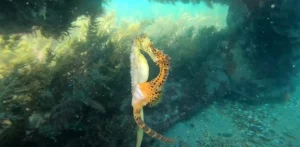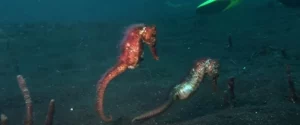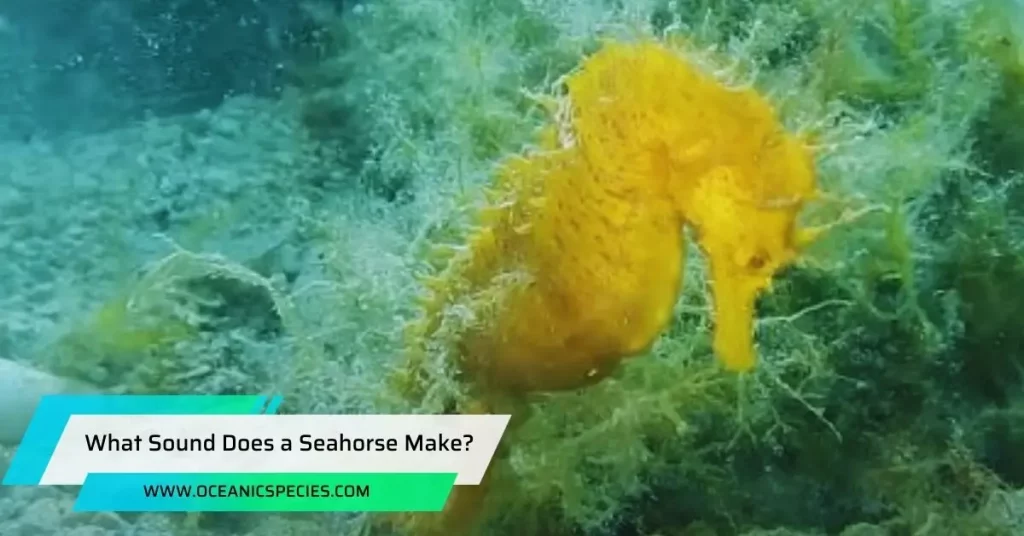A seahorse makes clicking sounds during courtship behavior and mating. These clicks are possibly amplified by their swim bladder.
Seahorses growl to chase away predators and serenade their partners, getting them in the right mood. This shows that seahorses, despite their appearance, have complex forms of communication and emotions. It is fascinating to discover the various sounds and behaviors exhibited by these marine creatures.
From growling to clicking, seahorses use unique methods to communicate and interact with their environment. We will explore the sound production of seahorses and delve into the reasons behind their vocalizations. Join us as we unravel the mystery of what sound a seahorse makes.
Sound Production In Seahorses
Seahorses produce sound through stridulation, which involves snapping and clicking sounds created by the bony edges of their skull and coronet. These sounds are amplified by their swim bladder and are often observed during courtship behavior.
Snap And Click Sounds Produced By Seahorses:
Seahorses have the ability to produce snap and click sounds. This sound production is known as stridulation. Stridulation is the process of rubbing together the bony edges of the skull and coronet, which results in the creation of these distinct sounds. These snap and click sounds can be quite loud and are believed to serve important purposes in seahorse communication and courtship behavior.
Stridulation Of Bony Edges Of The Skull And Coronet:
Seahorses possess unique skeletal structures that enable them to produce sounds through stridulation. By rubbing the bony edges of their skull and coronet together, seahorses create these distinctive snap and click sounds. Stridulation is a common behavior observed in various species of seahorses and is believed to play an important role in communication and territorial defense.
Possible Amplification By The Swim Bladder:
The snap and click sounds produced by seahorses may be further amplified by the swim bladder. The swim bladder is an internal air-filled sac that helps seahorses with buoyancy control.
It is hypothesized that the swim bladder may act as a resonating chamber, enhancing the sound produced by the stridulation of the bony edges. This amplification mechanism could make the snap and click sounds more audible and effective in seahorse communication.
Courtship Behavior And Sound Production
During courtship behavior, seahorses produce loud clicking sounds by stridulating the bony edges of their skull and coronet, possibly amplified by the swim bladder.

These sounds are used when the male and female seahorses embrace each other.
Loud Clicking Sounds During Courtship Behavior:
Seahorses produce loud clicking sounds during courtship behavior. The snaps and clicks are generated by stridulation of the bony edges of the skull and coronet. These sounds may be amplified by the swim bladder. Sound production has been observed when the male and female seahorses are embracing.
Male And Female Seahorses Alternately Produce Clicking Sounds:
Both male and female seahorses take turns producing clicking sounds during courtship. This alternating pattern of sound production is a unique characteristic of seahorses. The clicking sounds likely play a crucial role in attracting potential mates and communicating with one another.
Clicks Used To Attract Mates And Communicate:
The loud clicking sounds produced by seahorses serve as a form of auditory communication. These clicks are used to attract potential mates by signaling their availability and readiness to reproduce.

Seahorses may also use these sounds to establish and maintain social bonds with their partners. The specific pattern and intensity of the clicking sounds may convey important information about the seahorse’s reproductive status and behavior.
Remember, seahorses are fascinating creatures with unique courtship behavior and sound production. Their ability to generate loud clicking sounds during courtship is not only a means of communication but also a way to attract mates and establish social bonds.
The Meaning Behind Seahorse Growls And Clicks
Seahorses produce sounds through clicks and growls. These sounds are mainly used during courtship and mating, serving both as a way to chase away predators and to serenade their partners.
Seahorses may not be known for their vocalizations, but they do indeed produce sounds in the form of growls and clicks. These unique sounds serve a purpose in their communication and behavior. Let’s dive deeper into what these growls and clicks signify and how seahorses use sounds to communicate.
What The Growls And Clicks Signify:
- Predatory warning: Seahorses use growls and clicks as a warning sign to deter potential predators. These sounds serve as defensive mechanisms, alerting other organisms that they are not an easy target.
- Distress: Growling sounds can indicate distress or discomfort. When faced with a threatening situation or when feeling agitated, seahorses may emit these sounds to communicate their unease or fear.
- Territory defense: Clicking sounds are often used by seahorses to establish and defend their territory. These clicks can serve as a method of asserting dominance and warding off intruders.
How Seahorses Use Sounds To Communicate:
- Courtship rituals: Sound production plays a significant role in seahorse courtship rituals. Males and females engage in an intricate dance where they produce clicking sounds while embracing each other. These sounds serve as a means of attraction and synchronization between mates.
- Pair bonding: Seahorses are known for their monogamous behavior, and sounds can play a vital role in strengthening the bond between pairs. The exchange of clicking sounds during courtship helps to establish and maintain this intimate connection.
- Recognition and identification: Each seahorse produces unique clicking patterns, which may serve as a form of individual recognition. By listening to these sounds, seahorses can identify and locate their mates or offspring in crowded underwater environments.
Relationship Between Sound Production And Mating Success:
- Mating success: Producing quality and consistent sounds during courtship is often associated with higher mating success rates among seahorses. Males that can produce louder and more distinct clicks are more likely to attract females and secure successful mating encounters.
- Fitness indicator: The ability to produce strong and well-timed sounds can also serve as an indicator of the male’s fitness. It demonstrates the male’s strength and vitality, showcasing its ability to provide genetic advantages to potential offspring.
Frequently Asked Questions
Why Do Seahorses Click?
Seahorses click to communicate during courtship and mating, as well as to ward off predators.
Can Seahorses Growl?
Yes, seahorses can growl when they are angry or disturbed. They use growling as a form of communication.
How Loud Is A Seahorse Growl?
A seahorse growl can be loud and is used for communication and courtship behavior.
Conclusion
Seahorses, despite their delicate and serene appearance, are not as quiet as they seem. While they may not make the typical sounds we associate with animals, they have a unique way of communicating. Seahorses are known to produce clicking and snapping sounds by stridulating the bony edges of their skulls and coronets.
These sounds are believed to be amplified by their swim bladder, and they serve several purposes. One of the main reasons seahorses click is during courtship behavior, where both the male and female alternately produce loud clicking sounds while embracing.
These clicks act as a form of communication, signaling their readiness to mate. Additionally, seahorses also use their clicking sounds to chase away potential predators and establish boundaries. So, next time you see a seahorse, remember that beneath their tranquil exterior, they possess a secret language of clicks and snaps.

